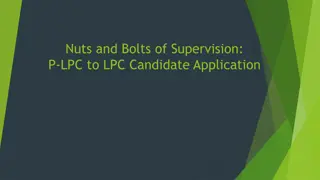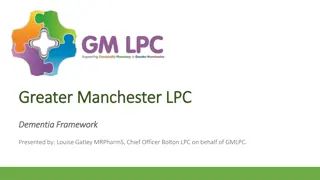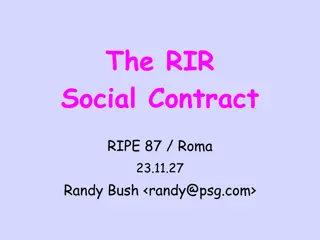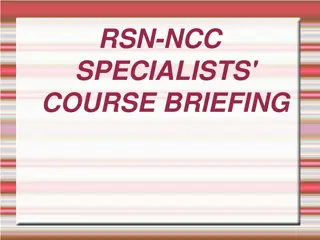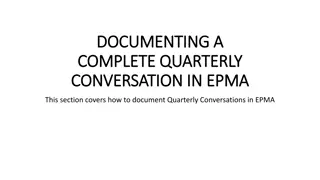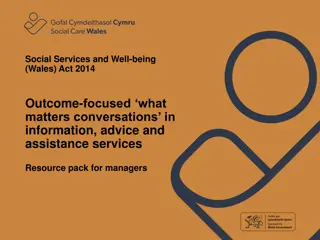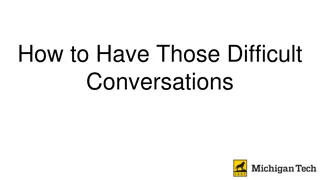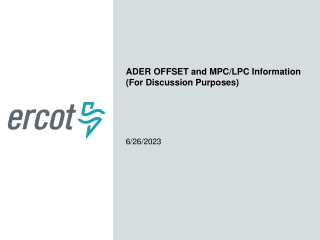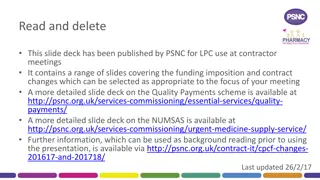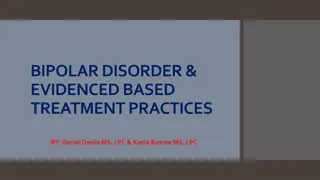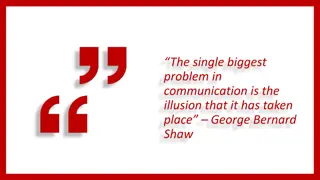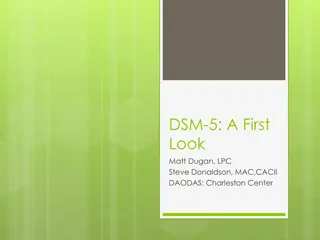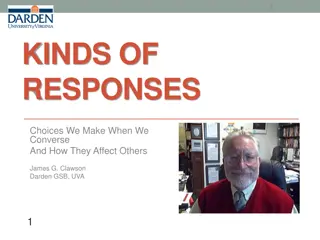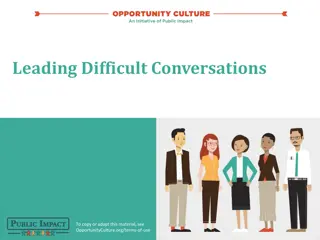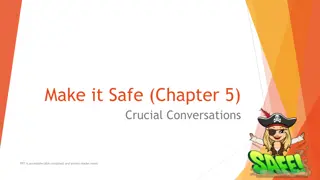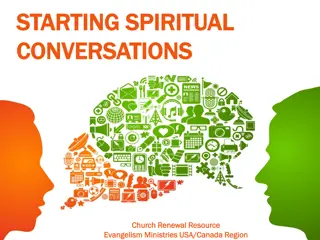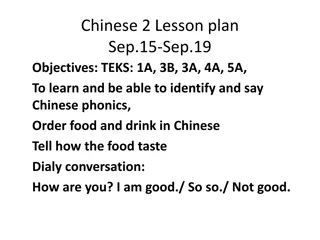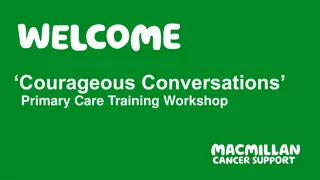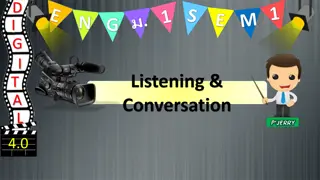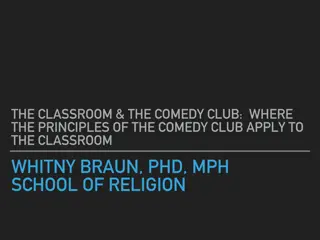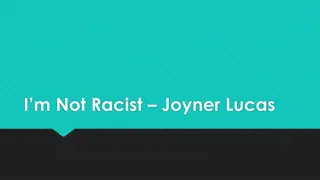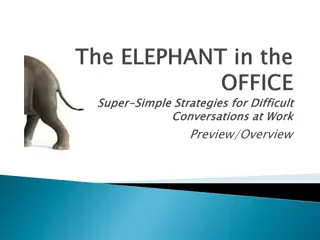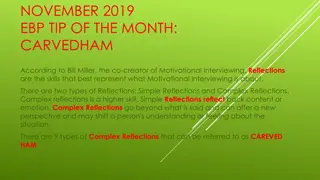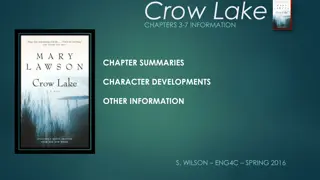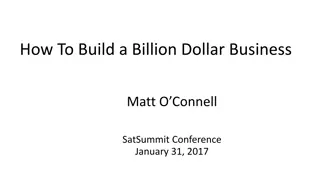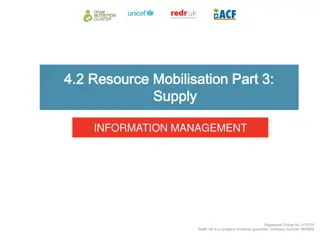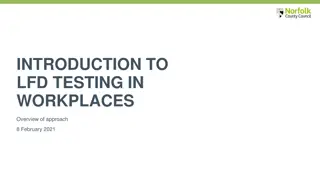Mastering Uncomfortable Conversations: O.A.R.S. Study Guide by Matt Miller, M.S., LPC, NCC
Discover the foundational principles of Motivational Interviewing with OARS, focusing on Open-ended Questions, Affirmations, Reflective Listening, and Summarizing. Learn how to engage clients effectively through genuine communication skills, positive reinforcements, and reflective listening to build rapport and trust. Enhance your coaching abilities and empower clients to navigate behavior change with confidence.
Download Presentation

Please find below an Image/Link to download the presentation.
The content on the website is provided AS IS for your information and personal use only. It may not be sold, licensed, or shared on other websites without obtaining consent from the author. Download presentation by click this link. If you encounter any issues during the download, it is possible that the publisher has removed the file from their server.
E N D
Presentation Transcript
O.A.R.S. The Art and Science of Uncomfortable Conversations Study Guide Matt Miller, M.S., LPC, NCC, BCC, ICAADC, AADC, MAC, CF-L2 Matt Miller Coaching 1
Foundation of Motivational Interviewing (MI): OARS The Basics Motivational Interviewing is, A directive, client centered counseling style for helping clients explore and resolve ambivalence about behavior change . - William R. Miller, 1991 2
O: Open-ended Questions A: Affirmations R: Reflective Listening S: Summarizing OARS are the foundation of MI skills. They are used regularly and consistently, and are a comfortable way of communicating with clients, family, and colleagues. Once you become comfortable with OARS they will become a natural interpersonal communication skill observable in all interactions. 3
Allow the client to speak more than their coach Allow the client to share information in their own words without input from their coach O: Open-ended Questions Coach must listen to what their client is saying in order to ask follow up questions Examples: How can I help you with _____ ? What is your goal today (this week, this month, this year) ? How has your life changed since you started CrossFit ? 4
Positive reinforcements/statements about a clients behavior that deserve recognition When behavior is acknowledged the client feels pride which can lead them to continue the positive behavior Build self-confidence in the client s belief they can change Support self-efficacy A: Must be genuine Examples: Congratulations on reaching your goal during today s workout ! You were working so hard on those _____ during the workout today it was awesome ! Affirmations 5
Significant in building rapport, trust, and impacts the desire to change Involves repeating, rephrasing and/or paraphrasing what the client tells you You must really listen to your clients and respond back to ensure understanding and to clarify R: Reflective Listening Sincere and genuine listening Examples: It sounds like you So what I hear you saying is You re wondering if 6
Repeating or Rephrasing: Listener repeats or substitutes synonyms or phrases, and stays close to what the speaker has said 3 Types of Reflective Listening Paraphrasing: Listener makes a restatement in which the speaker s meaning is inferred Reflection of Feeling: Listener emphasizes emotional aspects of communication through feeling statements 7
Can be used throughout a conversation but are particularly helpful at transition points Summarizing can help you to make sure you are on track with where the client is going S: Can also be done at the end of a conversation Summarizing Examples: Let me see if I understand so far I value what you say What you said is important 8
Statements made by clients that point towards their willingness to change Miller and Rollnick (2002) identified four types of change statements 1. Problem recognitions: My eating has gotten a little out of hand at times . Change Statements 2. Concern: If I do not start working out more consistently something bad is going to happen . 3. Intent to change: I m going to do something about my poor eating habits; I m just not sure what . 4. Optimism: I know I can get a handle on my overeating. 9
If a person expresses ambivalence, it is useful to include both sides in the summary statement. For example: On one hand you feel on the other hand you want to How to Respond to Ambivalence It can be useful to include information in summary statements from other sources to offer a full picture. Examples are professional research or other coaches. Be clear and concise. End with an invitation. For example: Did I miss anything ?, Is there anything you would like to add or correct ? 10
Develop Discrepancy DEARS: Used for Ambivalence Empathize Avoid Arguments Roll with Resistance Support Self-Efficacy 11
Compare positives and negatives of behavior Develop Discrepancy Use the pros and cons form to develop discrepancies Acknowledge self-motivational statements 12
Ambivalence is normal Be understanding of the fact that behavior change is difficult Empathize 13
Avoid Arguments Do not push for change Avoid labeling Change directions 14
Change strategies in response to resistance Roll with Resistance Acknowledge reluctance and ambivalence as understandable Reframe statements to create new momentum Engage client in problem-solving 15
Reinforce responsibility and ability to succeed Support Self- Efficacy Cultivate hope with menus of options 16
How does your (overeating/ inconsistency working out) fit in with your goals? On one hand you say your (health) is important to you; however, you continue to (binge eat) help me understand Motivational Strategies: Develop Discrepancies What do you feel you need to change to obtain your goals? How is being overweight working for you? And/or your family? How will things be for you a year from now if you continue to _______? Hypothetically speaking, if you were to make a change in any area of your life, what would it be? 17
How has owning this affected our relationships/family? But how is this a problem for YOU? What are your thoughts on what others are saying about your issue? Motivational Strategies: Owning Problems How has taking responsibility benefitted you? What are the possibilities that the worst-case scenario might happen? Give praise and support self-efficacy: You ve done well to have survived all that I can tell this has really bothered you 18
What are some of the good things your family or friends say about you? What do you see yourself doing a year from now? As a child, what did you want to be when you grew up? At what point in your life did that dream change? Once you reach your goal weight/fitness level what do you see as an ideal situation for you? What is it going to take for you to have the ideal situation? What steps can you take now to get closer to your goal? On a scale of 1-10 how confident are you that you will complete the next step? What sort of things are important to you? Give praise and Support Self-efficacy: Motivational Strategies: Life Goals It seems as though you have put a lot of thought into your goals You have got a good plan of action.. 19
Repeat/Rephrase clients ambivalence Motivational Strategies: Asking for a Decision You were saying you were trying to decide whether you should cut down on eating sugar or continue After discussion: On a scale of 1-10 how sure are you of your decision ? Tell me about your decision ? What is it you would like to do ? 20
Accept no decision empathize with difficulty of ambivalence Motivational Strategies: If No Decision What plan can be put in place if a decision is not made? What is standing in the way of making a decision? What do they need to feel comfortable with before making a decision? 21
Appropriate Motivational Strategies for Each Stage of Change 22
Appropriate Motivational Strategies: Establish rapport Client s Stage of Change : Precontemplation Ask permission Build trust Raise doubts or concerns in the client about current unwanted behavior Express concern and keep the door open 23
Appropriate Motivational Strategies: Shift focus from extrinsic to intrinsic motivation. Summarize client concerns. Assess where the client is on the decisional scale. Client s Stage of Change: Contemplation Explore the pros/cons of substance use and behavior change. Reexplore values in relation to change. Emphasize personal choice and responsibility. Explore the client's understanding of change and expectations of treatment. Reintroduce feedback. Explore self-efficacy. Summarize change talk. Enhance commitment to change. 24
Discuss steps the client feels are needed for change Clients Stage of Change: Preparation Have the client repeat goals and then rephrase them, using statements the client has previously mentioned Negotiate a change/plan/behavior contract. Consider and lower barriers to change Assist enlistment of social support. 25
Appropriate Motivational Strategies: Have client make a contract Provide information needed to make change (nutrition information, stretches, etc.) Client Stage of Change: Action Reinforce the importance of their commitment to changed behavior Acknowledge difficulties in the early stages Assist as needed with coping strategies Be supportive 26
Appropriate Motivational Strategies: Affirm the client s determination, accomplishments, and continued positive lifestyle Clients Stage of Change: Maintenance Review and document coping strategies with clients Encourage the client to support his/her lifestyle change through proactive friends and positive support systems 27
Bonus Content!!! Appropriate Motivational Strategies: Assist the client in reentering and understanding the change cycle Clients Stage of Change: Relapse Discuss the meaning of a relapse as a learning opportunity Agree on a plan if a lapse occurs in the future Help client develop new goals Support positive decisions to get back on track Offer encouragement 28


